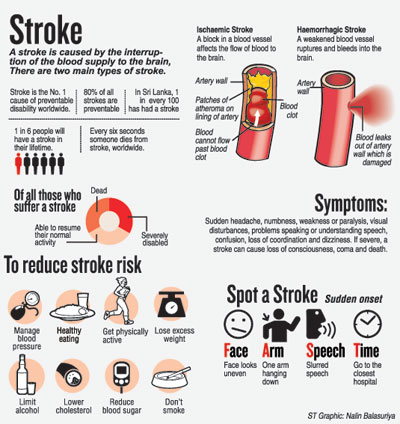News
Striking down stroke
‘Every one of us has a reason to prevent stroke.’
This, the theme of the World Stroke Day celebrated today, is the earnest plea of the Secretary of the National Stroke Association of Sri Lanka, Dr. Gamini Pathirana, who points the way how each and everyone could do this.
To the query, ‘Why’, the terrible data are put on the table –
1 in 6 will have a stroke or ‘brain attack’ in his/her lifetime.
Every 2 seconds someone is having a stroke somewhere in the world.
Globally, stroke is the 3rd leading cause of death after heart disease and cancer.
Stroke is the commonest cause of adult disability.
80% of the stroke burden is in the developing world.
There is a very strong silver lining to this grim, black cloud, with this Consultant Neurologist attached to the National Hospital, stressing that 90% of strokes are caused by 10 ‘avoidable’ or ‘controllable’ risk factors. This is where every single one of us can gauge our stroke risk and take remedial measures to overcome them.
These risk factors are: Hypertension, diabetes, high cholesterol, an unhealthy diet, lack of exercise, stress, smoking, excess alcohol, an abnormal rhythm in the heart (atrial fibrillation) and abdominal obesity.
Dr. Pathirana deals with –
Hypertension – Every person, after reaching 30 years of age should check his/her blood pressure once a year. If the blood pressure is high, the doctor will advise him/her how to bring down the blood pressure to be at the ‘target level of control’ with medication and lifestyle changes including eating healthily and exercising.
Firmly debunking the myth among people that “blood pressure can be felt”, Dr. Pathirana says that no one can feel blood pressure. It can only be measured by using the blood pressure equipment.
If diagnosed with hypertension, the person needs to be careful of his/her salt intake and avoid eating junk and processed food.
Blood sugar levels – The same rules, as in reducing high blood pressure, would apply to sugar levels as well, with regular checks needed.
“Both salt and sugar are killers,” he says, extolling the virtues of exercise which helps reduce high blood pressure and high blood sugar. Start exercising now gradually increasing the intensity to ½-hour per day for a minimum of 5 days per week.
Avoid stress – In an era when everything seems to be stressful, Dr. Pathirana urges people to set reachable targets in life and have time for relaxation which could come in any form such as meditation, listening to music or engaging in a hobby which works for that person.
Stop smoking – There is a need to stop smoking immediately. Even if the person is not smoking, check out whether there is passive smoking. There are medications to help those addicted to nicotine, he says.
Dr. Pathirana, meanwhile, deals with transient ischaemic attacks (TIAs), underscoring that unfortunately 70% of TIAs are not identified. As they are usually precursors of strokes, if treated, there is a strong chance of preventing a full-blown stroke.
The commonest indication that it is a TIA is a sudden onset of weakness on one side of the body, loss of speech; loss of balance; loss of strength in one arm or a leg; or difficulty in swallowing. These symptoms go away within an hour.
He urges anyone experiencing such a sudden onset which goes away within the hour to get to the nearest hospital, as there is a “high chance” of the TIA being followed by a disabling stroke. When the person seeks medical help, the doctors will identify the mechanism of stroke and prevent it. The common mechanism could be athero-thrombo embolism or cardio-thrombo embolism, which means blood-clots being set off.
TIAs are “warning symptoms” and need to be taken very seriously, he says, pointing out that they are like unstable angina (a chest pain) which is a precursor of a heart attack, where immediate action is needed.
However, if the symptoms persist it will be a stroke and he urges those close to the patient to take a look at the time and rush him/her to hospital. Get to hospital as fast as possible and as early as possible. The sooner a person who has suffered a stroke gets to hospital, more are the chances of salvaging brain tissue.
Looking deep into the brain, when an ischameic stroke (the blockage of an artery by a clot) hits it, Dr. Pathirana says that that area of the brain dies. Surrounding the dead area of the brain would be cells that are surviving but are under threat of death (penumbra). This is why it is vital to bring the patient to hospital immediately, so that doctors can promptly take action to salvage these cells that are surviving but are under threat.
Referring to rehabilitation which is vital, Dr. Pathirana compares and contrasts two situations where rehabilitation is provided and not provided. In the situation where rehabilitation is provided the peak improvement is higher when taking into account the disability score.
He adds: “Rehabilitation in a Stroke Unit in the first few weeks will help the patient get maximum improvement. A Stroke Unit is the best place for the treatment and management of stroke patients. Such a unit is an area defined for stroke patients where a multidisciplinary team is in attendance to help maximise improvements.”
In Sri Lanka, there are Stroke Units in most Teaching Hospitals and other major hospitals.

